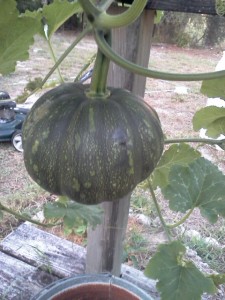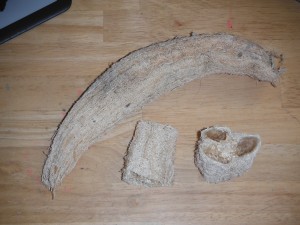I called this one “Alternates” since I have several other plant options for summer gardening in south Florida, but they aren’t as important to me (yet?), though I may have grown, or am growing them now.

The first on my list is the Everglades Tomato. Naturalized south of my location, they allegedly produce all year long, particularly during the summer months. I’ve mentioned them before, and probably will do so again. I only have a couple month’s worth of experience dealing with them, but if they live up to half the hype about them, they’ll become a mainstay with me. What they lack in size (NOT a slicing tomato!), they make up for in taste. Add in the fact that they tend to take over an area, I like `em!
 Seminole Pumpkins are a novelty mostly, due to pumpkins no longer being a food eaten regularly. There are always pies, and sometimes pumpkin bread, but who REALLY eats them anymore? And while I’ve made many pumpkin pies from scratch, most pumpkin pies made at home come from a store-bought can. We’ve tried pumpkin dumplings, and pumpkin soup, as well as using it in stir fry, all decent, but in itself rather bland. However, this is another naturalized gem that happens to date back to the indigenous tribes of the pre-Spanish years. Easy to start from seeds, once established, they RUN, covering everything, and even climbing trees….where it will grow pumpkins that hang down like ornaments. I LOVE that part about them! Fruits are smallish in size, the larger ones almost the size of a bowling ball. Flavor is pumpkin…and not overly sweet. Seeds are tasty though, and would probably be a reason for me to grow them again, though pickle worms were a menace. I ended up putting pantyhose over the young fruits to protect them. Seminole Pumpkins store very well, we kept a dozen or so on a top shelf in the kitchen, NOT an ideal place for pumpkin storage, but they lasted for about 10 months, just sitting there, NOT getting eaten. See the problem? The did eventually start to get soft, so we fed them to the chickens. Since we ate the eggs after that, does that count that we ate the pumpkins, if a step separated?
Seminole Pumpkins are a novelty mostly, due to pumpkins no longer being a food eaten regularly. There are always pies, and sometimes pumpkin bread, but who REALLY eats them anymore? And while I’ve made many pumpkin pies from scratch, most pumpkin pies made at home come from a store-bought can. We’ve tried pumpkin dumplings, and pumpkin soup, as well as using it in stir fry, all decent, but in itself rather bland. However, this is another naturalized gem that happens to date back to the indigenous tribes of the pre-Spanish years. Easy to start from seeds, once established, they RUN, covering everything, and even climbing trees….where it will grow pumpkins that hang down like ornaments. I LOVE that part about them! Fruits are smallish in size, the larger ones almost the size of a bowling ball. Flavor is pumpkin…and not overly sweet. Seeds are tasty though, and would probably be a reason for me to grow them again, though pickle worms were a menace. I ended up putting pantyhose over the young fruits to protect them. Seminole Pumpkins store very well, we kept a dozen or so on a top shelf in the kitchen, NOT an ideal place for pumpkin storage, but they lasted for about 10 months, just sitting there, NOT getting eaten. See the problem? The did eventually start to get soft, so we fed them to the chickens. Since we ate the eggs after that, does that count that we ate the pumpkins, if a step separated?

Luffa gourds are another option I’ve grown, as are all summer squashes, though, again, pickle worms are devastating on the zucchini and yellow squash. The luffas, however, were never bothered, and can be eaten like zucchini when young, before the fibers develop. Once those start, just sit back and wait. Once they’ve turned dry and brown, cut them down and let them dry some more. Then start picking the outer shell off. I think the variety I have was known for its tenacious outer shell. After picking off the outer shell, and shaking out the seeds (save them, they WILL breed true!), wash the sponge out, and bleach it if you want it a “cleaner” shade of brown. You now have one of nature’s BEST exfoliants!
 Mammoth Sunflowers are my favorite sunflowers to grow, partly because of the yield, partly because of the size, and partly because they make a GREAT trap crop for leaf-legged bugs. Simple to grow, I plant them on the south side of my beds to provide shade for my less tolerant plants to extend my growing season. The seeds are tasty too! The ones I don’t feed to the family go out to feed both the wild birds as well as a treat for my chickens, quail, and rabbits. Once I’ve harvested the seed heads, I leave the plants standing util all the leaves have fallen. Then I lay the stalks down along the edges of the bed as a mini version of hugelkultur, where the woody stems act as a water sponge as they break down, increasing the moisture in the soil.
Mammoth Sunflowers are my favorite sunflowers to grow, partly because of the yield, partly because of the size, and partly because they make a GREAT trap crop for leaf-legged bugs. Simple to grow, I plant them on the south side of my beds to provide shade for my less tolerant plants to extend my growing season. The seeds are tasty too! The ones I don’t feed to the family go out to feed both the wild birds as well as a treat for my chickens, quail, and rabbits. Once I’ve harvested the seed heads, I leave the plants standing util all the leaves have fallen. Then I lay the stalks down along the edges of the bed as a mini version of hugelkultur, where the woody stems act as a water sponge as they break down, increasing the moisture in the soil.
Other options I’ve tried or am trying include sugar cane, chayote, jicama, black-eyed peas, collard greens, eggplant, and okra. Other than the collards, I’ve had limited success, but I’m sure it was just my attempt failing (many were early in my gardening attempts), not that the plants in question won’t grow here.
Keep in mind you WILL have failures in summer gardens in Florida. And if you have my luck, during the season where EVERYTHING grows right, you’ll get a hurricane. Yes, I just jinxed you. But you’re ready for that already, aren’t you?
db
PS- Are you on Facebook? So am I! Go to FloridaHillbilly, and click “Like”, subscribe to my feed, and tell your friends! The more folks involved in growing some of their own food, the less likely they are to start eating cans of dog food while sitting on a hill overlooking an oil refinery.
More good ideas. Where did you get the Everglades Tomatoes? I’ll keep you posted on how the Solar Fire tomatoes fare in the Summer heat. I have high hopes for them if the bugs don’t get to them first.
From the same guys that sold me the malabar spinach 🙂
I have some seeds I”m fermenting to save for the future, as well as some cuttings I’m trying to get to take root. You’ll get some, I”m sure 🙂
And DO keep me posted on those Solar Fire’s, it will be interesting to see how they do, and how they taste.
I use pumpkin as a thickener for chili soups, stews, etc. Any pumpkin other than the small sugar or pie pumpkins are good for this. I can some as “mush” and some as chunks if it starts looking like they won’t keep much longer. I really like the second-hand pumpkin idea though. A lot less work, and the chicken makes them taste much better than I do. Enjoy.
I have some dried and some frozen, but I just can’t get myself to use it again. I’ve tried both, its fine, and even stores VERY well as a dried product. Re-hydrated, it turns into perfectly good pies. But it’s pumpkin. Maybe I’m jaded by its blandness 🙁
Hmmm…maybe some chili-lime pumpkin leather…. 🙂
And I hope you like Seminole Pumpkins, Mel….rumor has it some seeds are heading your way!
I use this recipe with squash of any kind, and instead of barley sometimes I use wheatberries: http://www.gridphilly.com/grid-magazine/2009/11/2/recipes-squash-your-hunger.html
Apparently you do have Seminole pumpkin. They actually get sweeter with storage and they develop a richer flavor. They also can be eaten within a few days of blossom as a summer squash, or cooked like an acorn squash or used like a butternut. I have a recipe for a soup with Seminole pumpkin, turkey kielbasa, and kale among other things in it that is absolutely tasty. I will track it down and send it to you. I grow these almost year round. They will grow bigger if you side dress them with quail manure after fruit set. But of course you have to like winter squash to like them. I just like having something s filling for my summer plates and my dog loves them to.
I look forward to the recipe!!